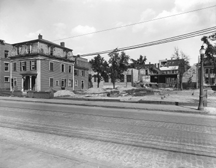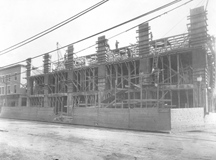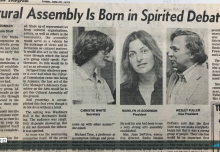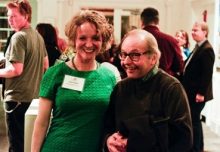Join us in learning more about ArtsWorcester’s new home, the Printers Building. In part one of a two-part series, Get to Know the Printers Building, we look at the history of the printing industry in Worcester and what led to the construction of the building itself.
Industrial Worcester


Before construction began, 1922
The scene: late nineteenth-century Worcester, an industrial hot spot. Developments of mills and factories along the Blackstone River fueled the economy, and by 1895, Worcester was one of the largest inland industrial cities in the country. Unlike many industrial towns, however, its manufacturing was diversified. Worcester’s economy did not depend on one product. From metals to paper products to corsets—if you wanted it, Worcester likely made it, and often in small shops.
These small businesses needed homes, but constructing their own facilities was risky and expensive. Instead, small-scale manufacturers began to rent space in larger buildings, and local architects took notice. Shared buildings popped up throughout the city. Coming together in these spaces made the worlds of industry and manufacturing easier to enter, and less of a financial risk. In addition, business in related fields could operate nearby one another, fostering cooperation and collaboration.
In the nineteenth century, printing was undergoing its own industrial revolution, shifting from hand-laid type to large printing presses. Meanwhile, printers served the growing commercial needs of new and expanded businesses. Previously a small-scale practice, printing became a specialized industry in Worcester that employed thousands. Though highly profitable, the industry was not without problems. Intense competition, labor disputes, and unfair rental prices threatened printers, so three local businessmen created the Printers Building Trust in 1922 to address these concerns.
Printers Coming Together


The Printers Building, October 16, 1922
Hamilton B. Wood of Commonwealth Press, Warren Davis of Davis Press (now Davis Publications), and Joseph Wesby of J.S. Wesby and Sons believed that they could help strengthen the industry. Like their colleagues in other small-scale industries, Worcester printers needed a shared building in which to operate. They also needed fair rental rates. Wood, Davis, and Wesby knew that they could create a building that would solve these issues. Construction of the Printers Building began August 1922, and in March of the following year, four printers, a binder, two engravers, and other related businesses moved in. The plan worked and the businesses thrived.
New York architect Walter S. Timmis designed the Printers Building and worked with E.J. Cross Construction to build it. By nature of their trades, the tenants required certain design features. Timmis paid close attention to their needs. He designed the middle floors to handle a heavier strain than other floors because of the massive printing presses they would house. Mushroom columns with flared tops helped support the heavy machines. The churning of large printing presses typically sent vibrations throughout a building, and the possibility of many operating at once posed a serious risk to architectural stability. The columns and concrete framing of the Printers Building limited vibrations caused by these machines and provided extra support.


The completed building, 1923
The design of the Printers Building represents an industrial take on the Classical Revival style, stripped to the structural basics of symmetry, repetition, and division. Inside, the mushroom columns are a utilitarian interpretation of Classical columns. On the exterior, the storefront entrances and divisions between windows demonstrate a Classical symmetry. The building also showcases Classical decoration with medallions and floral ornaments dividing decorative trimming around the first story. The medallions fittingly feature open books and remind passersby of the building’s original purpose. The combination of industrial functionality and Classical inspiration speak to the building’s history, as well as to its future as a center of creativity and innovation in Worcester.
To be continued next week!
This post is part of a series written and researched by Alice Dillon, ArtsWorcester Program Staff.
Images: Courtesy of Davis Publications




